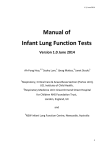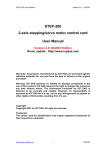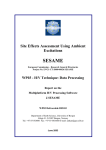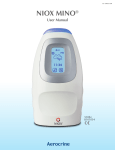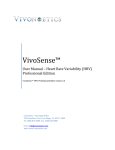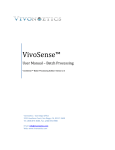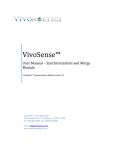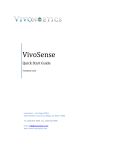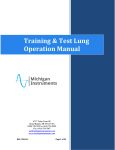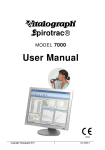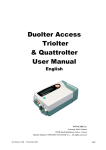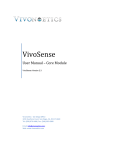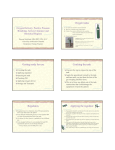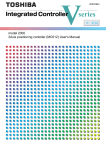Download VivoSense ® Complex Respiratory Analysis
Transcript
VivoSense User Manual – Complex Respiratory Analysis (CRA) VivoSense Complex Respiratory Analysis Version 2.0 Vivonoetics - San Diego Office 3231 Huerfano Court, San Diego, CA, 92117-3630 Tel. (858) 876-8486, Fax. (248) 692-0980 Email: [email protected]; Web: www.vivonoetics.com VivoSense – Complex Respiration Analysis Module Cautions and disclaimer The VivoSense software is not a medical diagnostic tool and is for research and investigational purposes only and is not intended to be, or to replace, medical advice or review by a physician. Copyright Notice Copyright © 2011 Vivonoetics. All rights reserved. User Documentation Complex Respiration Analysis Module Page 2 of 25 VivoSense – Complex Respiration Analysis Module Table of Contents 1. Introduction ............................................................................................................. 4 1.1. Complex Respiratory Analysis (CRA) for VivoSense ..................................................................... 4 1.2. System Requirements ..................................................................................................................... 4 2. 2.1. Respiration Background ......................................................................................... 5 Respiratory Physiology ................................................................................................................... 5 3. Thoraco-abdominal Measurement .......................................................................... 9 4. Calibration ............................................................................................................ 10 4.1. AB-RC Weightings ........................................................................................................................ 10 4.2. QDC Calibration ............................................................................................................................ 10 4.3. Fixed Volume Calibration (FVC) ................................................................................................... 13 4.4. Manually Editing Calibration Parameters ...................................................................................... 14 4.5. Restoring Default Calibrations ...................................................................................................... 14 4.6. Preferences ................................................................................................................................... 15 5. Respiration Processing Data Channels ................................................................ 16 6. Respiration Phase Space Plots ............................................................................ 19 7. CRA Exports ......................................................................................................... 23 8. CRA Layouts ........................................................................................................ 24 User Documentation Complex Respiration Analysis Module Page 3 of 25 VivoSense – Complex Respiration Analysis Module 1. Introduction 1.1. Complex Respiratory Analysis (CRA) for VivoSense Accurate and reliable measurements of respiratory functions are essential for assessing health, detecting and diagnosing disease, and assessing the efficacy and safety of a prescribed treatment. Disturbances in respiratory function are potentially life threatening and strongly impact clinical decision making. Respiratory abnormalities characterize a variety of disorders, including chronic obstructive pulmonary disease, pulmonary emphysema, restrictive lung disease, asthma, congestive heart failure, and epilepsy. In addition to physical disorders, ventilation is also profoundly affected by mental and psychophysiological states and disorders and detailed monitoring of respiratory function inside and outside the laboratory can greatly enhance our understanding of these phenomena. This manual describes a set of tools in the VivoSense software that may be used to further visualize and analyze non-invasive respiratory measurements. The types of measurements that may be used with this tool specifically result from the use of dual band inductance plethysmography (IP) sensors. IP is the gold standard for unobtrusive respiratory monitoring and has been used widely in clinical and research settings. The VivoSense Complex Respiratory Analysis software module includes analysis tools that enable a user to maximize the utility of respiratory measurements. These tools include the capability to appropriately calibrate respiratory data, visualize complex two dimensional phase space plots and derive a set of metrics and end points that reveal detailed information about a subject‟s respiratory state as a function of time. 1.2. System Requirements This module is an add-on analysis module to VivoSense. In addition to the VivoSense requirements, the CRA module has the following system requirements: Dual band respiratory inductance plethysmography (RIP) sensor system o The VivoSense CRA module is agnostic to the specific hardware system used to acquire the RIP data. User Documentation Complex Respiration Analysis Module Page 4 of 25 VivoSense – Complex Respiration Analysis Module 2. Respiration Background 2.1. Respiratory Physiology In respiratory physiology, respiration is defined as the transport of oxygen from the outside air to the cells within tissues, and the transport of carbon dioxide in the opposite direction. The respiratory system works in concert with a circulatory system to carry gases to and from the tissues. Respiration of oxygen includes four stages: Pulmonary ventilation -- moving of the ambient air into and out of the alveoli of the lungs. Pulmonary gas exchange -- exchange of gases between the alveoli and the pulmonary capillaries. Gas transport -- movement of gases within the pulmonary capillaries through the circulation to the peripheral capillaries in the organs, and then a movement of gases back to the lungs along the same circulatory route. Peripheral gas exchange -- exchange of gases between the tissue capillaries and the tissues or organs, impacting the cells composing these and mitochondria within the cells. Ventilation and gas transport require energy to power the heart and the muscles of respiration, mainly the diaphragm. In heavy breathing, energy is also required to power additional respiratory muscles such as the intercostal muscles. The energy requirement for ventilation and gas transport is in contrast to the passive diffusion taking place in the gas exchange steps. Respiratory behavior is correlated to the cardiovascular behavior to control the gaseous exchange between cells and blood. Both behaviors are intensified by physical activity. Just as blood moves through the cardiovascular system because of the pumping action of the heart, gas flows into and out of the lungs because of pressure gradients created by the diaphragm and thoracic cage. Although the abdominal and internal intercostal muscles are used for expiration during exercise or states of increased airway resistance, exhalation is usually a passive process, secondary to the elasticity of the lungchest wall. The flow of air is proportional to change in pressure over resistance. Thus, change in pressure drives ventilation and resistance opposes it. Inspiration occurs when the intrapulmonary pressure decreases to below atmospheric pressure - this can be secondary to an increase in intrapulmonary volume that occurs when the chest wall expands and the diaphragm descends towards the abdomen. Expiration occurs when the intrapulmonary pressure increases to exceed atmospheric pressure (or when intrapulmonary volume decreases). The following describes a series of relevant respiratory physiology terminology: COMPLIANCE is the ability of the lung to stretch; its distensibility. It represents the change in volume that occurs for a given change in pressure. It is inversely related to ELASTASTICITY, the ability of the lung to recoil to its resting volume after the stretching force is released. Elastance depends on the elastic tissue of the lung and chest wall. SURFACE TENSION is the collapsing pressure exerted upon the alveoli. It results from the attractive forces between molecules of liquid lining the alveoli and follows LaPlace‟s Law, P=2T/r, where P is the collapsing pressure, T is the surface tension and r is the radius of the alveolus. SURFACTANT lines the alveoli and reduces surface tension by disrupting intermolecular forces between molecules of liquid. This reduction in surface tension prevents alveoli from collapsing and increases compliance. RESISTANCE of the airway opposes the flow of gases. Air flow is characterized as Laminar when it is stream-lined, low velocity and follows Poiseuille's Law. It is usually confined to the small peripheral airways. Air flow is characterized as turbulent when the movement of molecules of gas is disorganized; it occurs when User Documentation Complex Respiration Analysis Module Page 5 of 25 VivoSense – Complex Respiration Analysis Module velocity of flow exceeds a limiting value or when irregularities in the configuration of the airway preclude laminar flow. It follows POISEUILLE’s LAW, an equation which describes laminar flow in a straight tube, i.e. laminar flow: 4 V=Pr /8nl, where V= flow P= driving pressure r= radius of tube n= fluid viscosity l= length of tube Since length and viscosity of the airway are usually constant, the radius (or diameter) of the airway is the most powerful determinant of airway resistance (resistance and radius are inversely related). The smaller the airway radius, the greater the resistance to flow. Nearly 90% of airway resistance can be attributed to the trachea and bronchi, both characterized by rigid structures and together accounting for the smallest total cross-sectional area of the airway. VENTILATION, which can be spontaneous (as in breathing) or artificial (as in mechanical ventilation) is the movement of AIR [Air is a mixture of gases. According to Dalton‟s Law, the total pressure of a mixture of gases is the sum of the pressures of the individual gases. In dry air, at an atmospheric pressure of 760 mm HG, 78% of the total pressure is due to nitrogen molecules and 21% is due to oxygen.] between the environment and the alveoli. It is measured as the frequency of breathing multiplied by the volume of each breath. Ventilation maintains normal concentrations of oxygen and carbon dioxide in the alveolar gas and, through the process of diffusion, also maintains normal partial pressures of oxygen and carbon dioxide in the blood flowing from the capillaries. MINUTE VENTILATION, or the volume of gas ventilated in one minute, is expressed as TIDAL VOLUME x BREATHS/MIN. ALVEOLAR VENTILATION, or the volume of gas available to the alveolar surface per minute, is expressed as (TIDAL VOLUME–DEAD SPACE) X BREATHS/MIN. Ventilation and perfusion are normally matched in the lungs so that gas exchange (ventilation) nearly matches pulmonary arterial blood flow (perfusion). If mismatched, impairment of oxygen and carbon dioxide transfer results. The concentration of oxygen (PO2) in any lung unit is measured by the ration of ventilation to blood flow: VENTILATION/PERFUSION or V/Q. This relationship also applies to carbon dioxide, nitrogen and any other gas present. The Ventilation – Perfusion relationship can be measured by calculating the alveolar (a) – Arterial (A) PO2 difference. PAO2 can be calculated using the equation: FIO2 (Patm – PH2O) – (PaCO2/R) The three basic elements of the respiratory control system are: SENSORS, CENTRAL CONTROLLERS and EFFECTORS. SENSORS: The sensors that contribute to the control of breathing include lung stretch receptors in the smooth muscle of the airway, irritant receptors located between airway epithelial cells, joint and muscle receptors that stimulate breathing in response to limb movement, and juxtacapillary (or J) receptors located in alveolar walls which sense engorgement of the pulmonary capillaries and cause rapid shallow breathing. The most important sensors are central chemoreceptors in the medulla as well as peripheral chemoreceptors in the carotid and aortic bodies. The central chemoreceptors in the medulla respond to changes in the pH of the CSF. Decreases in CSF pH produce increases in breathing (hyperventilation) whereas increases in pH result in hypoventilation. The peripheral chemoreceptors in the carotid and aortic bodies cause an increase in ventilation in response to decreases in arterial PO2, increases in arterial PCO2 and increases in arterial hydrogen concentrations (decrease in pH). CENTRAL CONTROLLERS: Central control of breathing is achieved at the brainstem, specifically the pons and midbrain, (responsible for involuntary breathing) and the cerebral cortex (responsible for voluntary breathing). EFFECTORS: The “effectors” are the muscles of respiration, including the diaphragm, intercostal muscles, abdominal muscles and accessory muscles such as the sternocleidomastoid User Documentation Complex Respiration Analysis Module Page 6 of 25 VivoSense – Complex Respiration Analysis Module Lung volumes and capacities (capacities are the summation of volumes) are summarized in the following (See Figure 1): Figure 1. Common pulmonary volumes and capacities TIDAL VOLUME (Vt): Waveform of volume of inspired or expired with each normal breath. Actual volumes are peak to trough differences. INSPIRATORY RESERVE VOLUME (IRV): Maximum volume that can be inspired over the inspiration of a tidal volume/normal breath. Used during exercise/exertion. EXPIRATRY RESERVE VOLUME (ERV): Maximal volume that can be expired after the expiration of a tidal volume/normal breath. RESIDUAL VOLUME (RV): Volume that remains in the lungs after a maximal expiration. This volume cannot be measured by spirometry. INSPIRATORY CAPACITY (IC): Volume of maximal inspiration: IRV + TV FUNCTIONAL RESIDUAL CAPACITY (FRC): Volume of gas remaining in lung after normal expiration, cannot be measured by spirometry because it includes residual volume: ERV + RV VITAL CAPACITY (VC): Volume of maximal inspiration and expiration: IRV + TV + ERV = IC + ERV TOTAL LUNG CAPACITY (TLC): The volume of the lung after maximal inspiration. The sum of all four lung volumes, cannot be measured by spirometry because it includes residual volume: IRV+ TV + ERV + RV = IC + FRC DEAD SPACE: Volume of the respiratory apparatus that does not participate in gas exchange, approximately 300 ml in normal lungs. --ANATOMIC DEAD SPACE: Volume of the conducting airways, approximately 150 ml --PHYSIOLOGIC DEAD SPACE: The volume of the lung that does not participate in gas exchange. In normal lungs, is equal to the anatomic dead space (150 ml). May be greater in lung disease. User Documentation Complex Respiration Analysis Module Page 7 of 25 VivoSense – Complex Respiration Analysis Module FORCED EXPIRATORY VOLUME in 1 SECOND (FEV1): The volume of air that can be expired in 1 second after a maximal inspiration. It is normally 80% of the forced vital capacity, expressed as FEV1/FVC. In restrictive lung disease both FEV1 and FVC decrease , thus the ratio remains greater than or equal to 0.8. In obstructive lung disease, FEV1 is reduced more than the FVC, thus the FEV1/FVC ratio is less than 0.8. User Documentation Complex Respiration Analysis Module Page 8 of 25 VivoSense – Complex Respiration Analysis Module 3. Thoraco-abdominal Measurement The Complex Respiratory Analysis module is intended for use with dual band inductance plethysmography (IP) sensors. IP is the gold standard for unobtrusive respiratory monitoring and has been used widely in clinical and research settings. Several thousand published scientific studies have used this technology and established it as the standard for non-invasive assessment of the pattern of breathing. An IP sensor consists of a sinusoidal arrangement of electrical wires embedded in elastic cotton bands. A high frequency, low voltage oscillating current is passed through the wires to generate a magnetic field needed to measure the self-inductance of the coils, which is proportional to the cross-sectional area surrounded by the band. No electrical currents are passed through the body. Use of this measurement methodology approximates the amount of air moved by the respiratory system by measuring the expansion and contraction of both the rib cage (RC) and abdominal (AB) compartments. The RC motion reflects activity mostly of the intercostal muscles and to a lesser extent the accessory muscles while AB motion mostly reflects activity of the diaphragm. Thus this requires two bands, with one placed at the level of the thorax and the other at the level of the abdomen (See Figure 2). Measurement of respiration using dual band IP technology requires additional signal processing and analysis to wholly exploit the value of these measurements. It is important to appropriately calibrate these measurements and assign relative weightings for the contribution of each respiratory compartment. Once calibrated, there are many additional measures that may be derived from two band respiration and these will be discussed in the ensuing chapters. Figure 2. Dual Band Respiratory Inducutance Plethysmography User Documentation Complex Respiration Analysis Module Page 9 of 25 VivoSense – Complex Respiration Analysis Module 4. Calibration There are several possible methods for calibrating dual band respiratory measurements. VivoSense software allows for the following types of calibration: 1. Qualitative Diagnostic Calibration (QDC): This is used to weight the relative gains of each respiratory compartment and should be applied prior to any other calibrations. QDC calibrations may be applied automatically or manually. 2. Fixed Volume Calibration (FVC). This calibration sets the overall gain of the volume signal so that the average breath volume over the calibration period is equal to an externally measured breath volume. This may be from a fixed volume bag or a spirometer / flowmeter. It is recommended to apply a FVC calibration following a QDC calibration. VivoSense automatically applies a default calibration upon import of a data file. This calibration weights the AB and RC bands with equal unit weighting and scales the average volume over the entire duration of the session to 400ml. 4.1. AB-RC Weightings The Calibration of a single band system implies the conversion of computer units to physical units. The simplest case is a linear approximation which requires the scaling of the waveform by a constant gain factor. The purpose of any calibration procedure is the numerical determination of this factor. This scenario of a linear approximation can be immediately generalized to the case of a dual band system. Here, the tidal Volume, Vt, can be expressed simply as sum of the filtered and calibrated thoraco-abdominal waveforms After identification of an appropriate region, the actual QDC algorithm will be run to determine relative weightings for both AB and RC bands. These may be represented as follows: Here, RCu and ABu are the uncalibrated waveforms and (AB gain), (RC gain) are the calibration parameters. Alternatively, Vt can be parameterized as where is the constant relative calibration parameters introduced in favor of (AB gain) and (Gain) is equivalent to (RC gain). These calibration parameters need to be approximated before any breath detection can be applied. A good staring value for Kratio is 1 while an approximate value for (RC gain) can be derived from the raw waveforms by the same method used for single band respiration systems described in ref. (1). 4.2. QDC Calibration The QDC calibration is based on the principles of the iso-volume maneuver calibration (see ref. (1)) and it is thus necessary to identify a suitable period of quiet natural breathing to perform this calibration over. The User Documentation Complex Respiration Analysis Module Page 10 of 25 VivoSense – Complex Respiration Analysis Module default recommended duration for a QDC calibration is a 5 minute period, however it is possible to override this duration should it be necessary to calibrate over shorter or longer periods. Automatic QDC VivoSense software is able to search an entire session for the most appropriate 5 minute period of natural or quiet breathing to ensure optimal QDC results. To enable this search, select from the Session Menu, Session->Calibration->QDC Automatic. Following this VivoSense will determine the most suitable calibration period and perform a QDC calibration. If the calibration procedure is successful the user will be prompted with the dialog similar to Figure 3. Figure 3: QDC Calibration Summary If the user accepts these values, they will be used to rescale the respiratory waveforms. All dependent channels will also be recomputed. In addition, an annotation named „QDC Calibration‟ will be created to indicate the period used by the calibration. The color of the annotation will be Aquamarine to signify that this was an automatically identified region. Manual QDC Should the user not wish to use the automated region identification feature in VivoSense, it is possible to do this manually. To do so, it is necessary to have „Insp Vol‟, „Exp Vol‟ or at least one channel contained in the „Respiration/Waveform/Volumes‟ folder plotted on a chart. Subsequently, the user can select the menu item labeled „Calibration/QDC Calibration‟. This menu item can be accessed by right- clicking on the chart at start of the calibration period. In this case the default QDC period (as specified in Preferences; see section 4.6) will be used. Alternatively, the user can specify start time and period duration by selecting a rectangular region of data on the corresponding chart using the left mouse button. The duration of the QDC period is unconstrained as long as the period encompasses a sufficient number of good breaths. The minimum number of breaths needed for a successful QDC calibration and the average breath volume are also specified in Preferences (see section 4.6). If the calibration procedure was successful the user will be prompted with the dialog shown in Figure 3 (see Automatic QDC for more details). User Documentation Complex Respiration Analysis Module Page 11 of 25 VivoSense – Complex Respiration Analysis Module Unsuccessful QDC It may occur that insufficient breaths were available for a QDC calibration in which case the routine will report a failure to calibrate (see Figure 4). Figure 4: Unsuccessful QDC Calibration If this occurs, one should examine the breath detection properties and ensure that accurate breath detection is being performed. To do so, open any channel in the respiration measures folder and expand the Parameters Properties to reveal the Breath Detector Settings seen in Figure 5. This allows over-ride of a single parameter called Minimum Tidal Volume. This parameter assumes a default average volume of 400ml but may operate off a calibrated volume. This represents the minimum volume that must be exceeded for a breath to be considered a true breath. Decreasing this will result in more peak-trough excursions being considered as a breath and increasing this will result in fewer considerations. It is recommended that one of the Breath Detection & Calibration Layout for your Import Module be used when adjusting this setting. Figure 5. Breath Detector Settings User Documentation Complex Respiration Analysis Module Page 12 of 25 VivoSense – Complex Respiration Analysis Module If it is certain that a correct breath identification has occurred and a failure to calibrate still results, it may be necessary to adjust the QDC duration or location to enable this to perform correctly. If neither of these results in a suitable calibration then this suggests a problem with the actual recording, and it is recommended that a new session be recorded. 4.3. Fixed Volume Calibration (FVC) A successful QDC calibration will rescale Vt such that the average breath volume over the QDC region will be equal to the default breath volume specified in the preferences (see section 4.6). Note: the primary purpose of QDC is the determination of the K-ratio while the overall gain factor (RC gain) is based on the assumption that the average breath volume is known. The accuracy may be improved by performing a FVC on a selected set of breaths. Note: while any FVC only changes the value of (RC gain) and keeps (K-ratio) constant, QDC modifies both (K-ratio) and (RC gain). If simultaneous additional volume measurements were made with an external device such as a fixed volume bag or spirometer, it may be possible to further calibrate the respiration volumes for greater accuracy. To do so, it is necessary to identify the location of the external measurement in the VivoSense session. Depending on the recording device used, there may be annotations associated with this region to help locate it. Once the region is located, it is necessary to plot the Insp Vol channel on the SCP. This channel is located in the Respiration->Measures->Volumes folder in the Data Explorer. It is also available on the Breath Detection & Calibration layout for convenience. The user may then select the region containing the breaths used in the external measurement with the mouse and upon releasing the mouse button a context menu will appear containing the item: „Calibration/Respiration/ Fixed Volume Calibration‟. Selecting this will result in a dialog in which you may enter the actual volume obtained with the external device (see Figure 6). VivoSense will then scale the average value of the selected breaths to be equal to this volume. User Documentation Complex Respiration Analysis Module Page 13 of 25 VivoSense – Complex Respiration Analysis Module Figure 6: Fixed Volume Calibration 4.4. Manually Editing Calibration Parameters The calibration parameters are available as properties in the Vt channel for manual editing. This can be used to reuse calibration parameters computed in another session from the same subject. 4.5. Restoring Default Calibrations In general, a calibration procedure requires a certain number of identified breaths. However, occasionally it can happen that the respiratory waveforms are poor and a suitable region with enough good breaths cannot be found. In this case it may be necessary to reset the calibration parameters to their default values. This can be done by selecting Session>Calibration>Reset QDC or Session>Calibration>Reset FVC. Both procedures will reset the gain factor. The difference is that each procedure will only remove the annotation related to the specified calibration and leave the others unchanged. In addition, resetting the QDC calibration will also set the K-ratio to „1‟ while resetting FVC will retain the K-ratio. User Documentation Complex Respiration Analysis Module Page 14 of 25 VivoSense – Complex Respiration Analysis Module 4.6. Preferences User preferences for respiratory parameters can be accessed by going to „Tools->Preferences‟ and clicking on the „Respiration‟ tab (See Figure 7). The configurable parameters are: Calibration Period This is the default duration for a QDC calibration. Minimum Number of Breaths This is the minimum number of breaths required for a QDC calibration. Figure 7. Respiration Preferences for Calibration User Documentation Complex Respiration Analysis Module Page 15 of 25 VivoSense – Complex Respiration Analysis Module 5. Respiration Processing Data Channels The core VivoSense software module supports a basic single channel of respiratory plethysmography. This single channel may result from a single measurement band or the un-weighted sum of two measurement bands. The plethysmograph sensors supported by the core may originate from a variety of sensor types including but not limited to piezoelectric strain gauges, hall effect magnetometers and inductance bands. The VivoSense CRA module supports respiratory measurements arising from two breathing compartments. This allows the derivation of several additional measures that assess the degree of co-ordination between these two compartments. In addition to these measures, this module also allows access to a number of patented metrics to assess the magnitude of neural drive to the respiratory center. This manual describes only those respiratory channels that are not included in the core module. However, all core channels are still available. Respiration Waveforms AB:Abdominal Respiration AB is the filtered and scaled respiratory abdominal wave form. RC:Rib Cage (Thoracic) Respiration RC is the filtered and scaled respiratory abdominal wave form. dRC: Derivative of RC Excursions Flow from the RC band only. dAB: Derivative of AB Excursions Flow from the AB band only. d2RC: 2nd Derivative of RC Excursions Acceleration from the RC band only. d2AB: 2nd Derivative of AB Excursions Acceleration from the AB band only. Respiration Measures All respiration measures are computed on a breath by breath basis, referenced to the time of the beginning of inhalation on the Vt waveform. Timing Measures: Tpef/Te: Time to reach peak expiratory tidal flow over expiration time This is the time to reach peak expiratory tidal flow as a percentage of expiratory time. User Documentation Complex Respiration Analysis Module Page 16 of 25 VivoSense – Complex Respiration Analysis Module Phase Measures: %RCi : Percent Rib Cage Inspiratory Contribution to Tidal Volume Ratio The %RCi contribution to Tidal Volume ratio is obtained by dividing the inspired volume in the RC band by the inspired volume in the algebraic sum of RC + AB at the point of the peak of inspiratory tidal volume. %RCe: Percent Rib Cage Expiratory Contribution to Tidal Volume Ratio The %RCe contribution to Tidal Volume ratio is obtained by dividing the expired volume in the RC band by the expired volume in the algebraic sum of RC + AB at the point of the peak of expiratory tidal volume. Ph Rel Insp: Phase Relation during Inspiration This measure of phase relation expresses the percentage agreement between direction of RC and AB movements during the inspiratory phase of respiration. Ph Rel Exp: Phase Relation during Expiration The measure of phase relation expresses the percentage agreement between direction of RC and AB movements during expiration. It is computed in the same way as Ph Rel Insp except that the expiratory limb of respiration is sampled. Ph Rel Total: Phase Relation of Entire Breath This measure of phase relation expresses the percentage agreement between direction of RC and AB movements during the entire breath. It is computed in the same way as Ph Rel Insp except that both inspiratory and expiratory limbs of respiration are sampled. |Ph Angle|: Absolute value of AB-RC Phase Angle The phase angle is computed from Lissajous loops between RC and AB excursions (also known as KonnoMead loops) (2). A phase angle of 0° indicates perfect in-phase movement while a value of 180° indicates completely out-of-phase movement between the two compartments. Phase angle determinations do not require calibration of RIP since they depend solely upon timing relationships between RC and AB movements. Phase angle computations assume that respiratory excursions are sinusoidal (when in fact they are not) and therefore values may differ from computations of similar timed electrically generated sine waves. Ph Angle(Area): AB-RC Phase Angle For perfect sin waves the area closed loop covering one cycle can be expressed in terms of the phase angle as The sign of the phase angle indicates whether AB is ahead of RC (in our convention this means: Ph Angle>0) or behind (Ph Angle<0). |Ph Angle(Area)|: Absolute value of Ph Angle(Area) Same as |Ph Angle| but computed using the entire enclosed area. User Documentation Complex Respiration Analysis Module Page 17 of 25 VivoSense – Complex Respiration Analysis Module Respiratory Drive Measures: Vt/Ti: Mean Inspiratory Flow The mean inspiratory flow is a measure of respiratory center drive. The higher its value, the greater the drive and vice-versa. In situations in which thoracoabdominal discoordination is present, Vt/Ti may underestimate drive since it does not take into account the drive needed to move the paradoxically moving compartment. In obstructive apneas where respiratory efforts take place, the value of Vt/Ti approaches zero and therefore falsely indicates that no drive is present. In this situation, respiratory drive is better measured from drive measures of the RC or AB compartments. Respiration Trends Trends exist for all the above respiration measures contained in mirrored trend folders. User Documentation Complex Respiration Analysis Module Page 18 of 25 VivoSense – Complex Respiration Analysis Module 6. Respiration Phase Space Plots Phase Charts A Phase Chart contains a single Phase Plot of multiple data channels in the session: the Y Channel, X Channel, and optionally a Trigger Channel. The Y Channel is plotted on the y-axis against the X-Channel on the x-axis. The units of the axes are specific to each data channel. Arrows along the plot reference the direction forward in time. Figure 8 shows a Synchronized Chart Panel with two Time Series Charts (Compartments and Combined), and two Phase Charts (Konno-Mead and Flow-Volume). New Phase Charts can be added by right-clicking on the SCP area and choosing Chart->New->Phase. The user will be prompted to select the Y Channel, X Channel, and optional Trigger Channel when the Phase Chart is added. Phase Plots are discussed in the following section. Figure 8. Synchronized Chart Panel With Phase Charts Trigger Channel The Trigger Channel is optional (but also must be set when the Phase Chart is created). It is the channel that triggers the range of data shown on the Phase Plot. When no Trigger Channel is set, then Phase Chart will User Documentation Complex Respiration Analysis Module Page 19 of 25 VivoSense – Complex Respiration Analysis Module plot the data within the time range displayed in the SCP. When a Trigger Channel is specified, then the range of data plotted is specified by the crosshair cursor position on the SCP, Trigger Channel, Trigger Count, and Trigger Offset. For example to plot Vt vs dVt (Flow-Volume) for three breaths from the crosshair cursor, set the Trigger Channel to Resp Rate, Trigger Count to 3, and Trigger Offset to 0. To plot the three breaths following those, set Trigger Count to 3 and Trigger Offset to 3. (See Figure 9). Figure 9. Selecting the Trigger Channel and Settings The Trigger Count and Trigger offset may be modified in the phase plot properties (See Figure 11). Phase Plots A Phase Plot is a visualization of one Data Channel versus another Data Channel within a given Phase Chart. For each Phase Plot added to a chart, there is a legend symbol. To modify the Phase Plot properties, make sure the Properties window is visible, and click on the Legend Symbol. Phase Chart Properties To modify the Phase Chart properties, make sure the Properties window is visible, and click on the Phase Plot. The Phase Chart Properties provides control over the colors and name of the chart, as well as how the data is scaled in the Auto Scale property. Set Auto Scale to XYAxis_Symmetric to show the entire data set, and have equal range. This is useful if the shape of the curve (circular vs elliptical) is important. Set Auto Scale to XYAxis to have each axis scale independently. (See Figure 10). User Documentation Complex Respiration Analysis Module Page 20 of 25 VivoSense – Complex Respiration Analysis Module Figure 10. Phase Chart Properties Phase Plot Properties The Phase Plot properties provides control over the line and point color, style, width/size while also providing access to alternate ways of visualizing the plot, such as “Line Staircase” mode and “Spike” visualization. User Documentation Complex Respiration Analysis Module Page 21 of 25 VivoSense – Complex Respiration Analysis Module Figure 11. Phase Plot Properties Other Phase Plot Properties include settings for color, style and size/width for lines and points. To turn points or lines on/off, use their Style property and set the Point Style to None, or Line Style to None. To turn directional arrows off, set the Arrow Count to 0. Lines can be visualized using the Staircase mode, where the value of the plot is maintained between points instead of using linearly interpolating the values. This results in a “staircase” appearance of the plot. To use this feature, set the Line Staircase property to true. (See Figure 11). User Documentation Complex Respiration Analysis Module Page 22 of 25 VivoSense – Complex Respiration Analysis Module 7. CRA Exports To assist with the export of Complex Respiratory Analysis data, pre-configured exports are available in the VivoSense CRA module. Exporting data using the standard core export functionality will allow the generation of CRA exports that are meaningful. For example selecting a known range and exporting data in that range will provide a table of CRA indices and the corresponding exported values. The preconfigured CRA exports under “Complex Respiratory Analysis” are: 1. 2. 3. 4. 5. All Respiratory Measures: all Respiration measures channels All Respiratory Trends: All Respiration trend channels All Respiratory Waveforms: All Respiration waveform channels Phase Relation Measures: all Phase Angle channels Phase Relation Trends: all Phase Angle trend like channels User Documentation Complex Respiration Analysis Module Page 23 of 25 VivoSense – Complex Respiration Analysis Module 8. CRA Layouts The VivoSense software contains a collection of Layouts specific to the Complex Respiratory Analysis module. The following layouts are provided with this module. Basic The Basic Layout contains phase plots of Konno-Mead (AB vs RC) and Flow-Volume Loops (Vt vs dVt) as well as the basic respiratory volume charts containing AB and RC as well as Vt. Flow Volume This Layout contains the Flow-Volume Loop phase plots. The Flow-Volume 1 chart has a Trigger Count of 3 and a Trigger Offset of 0, while the Flow-Volume 2 chart has a Trigger Count of 3 and a Trigger Offset of 3 seconds. The layout also contains waveform plots of Vt and dVt. Flow Volume Loops may be used to illustrate obstructive or restrictive lung disease in individual subjects. Konno-Mead This Layout contains the Konno-Mead phase plots. The Konno-Mead 1 chart has a Trigger Count of 3 and a Trigger Offset of 0, while the Konno-Mead 2 chart has a Trigger Count of 3 and a Trigger Offset of 3 seconds. The layout also contains waveform plots of AB, RC and Vt. The monitoring of thoraco-abdominal asynchrony as displayed in the Konno-Mead plots is a useful, non-invasive indicator of respiratory muscle load or respiratory muscle dysfunction and can be used to determine response to therapy in individual subjects. Phase Angle The Phase Angle Layout contains Phase Angle plots (Phase Angle and Phase Angle Area) as well as the percent Rib Cage contribution to inspiration and expiration. This layout may be used to determine the relative contribution and synchrony to breathing of the Rib Cage and Abdominal compartments. User Documentation Complex Respiration Analysis Module Page 24 of 25 VivoSense – Complex Respiration Analysis Module 9. Bibliography 1. Vivonoetics. Vivosense Core Manual. 2010. 2. Calibration of respiratory inductive plethysmograph during natural breathing. Sackner MA, Watson H, Belsito AS, Feinerman D, Suarez M, Gonzalez G, Bizousky F, Krieger B. 1989 Jan;66(1), J Appl Physiol, pp. 410-20. 3. Validation of the phase angle technique as an objective measure of upper airway obstruction. Hammer, J, Newth, CJL and Deakers, TW. s.l. : Pediatr Pulmonol, 1995, Vols. 19: 167-173. User Documentation Complex Respiration Analysis Module Page 25 of 25

























